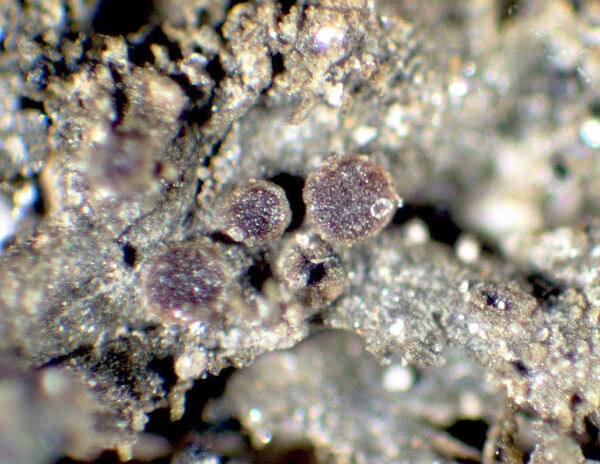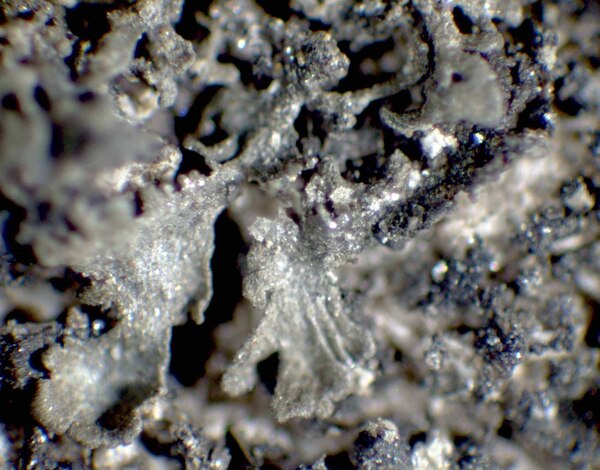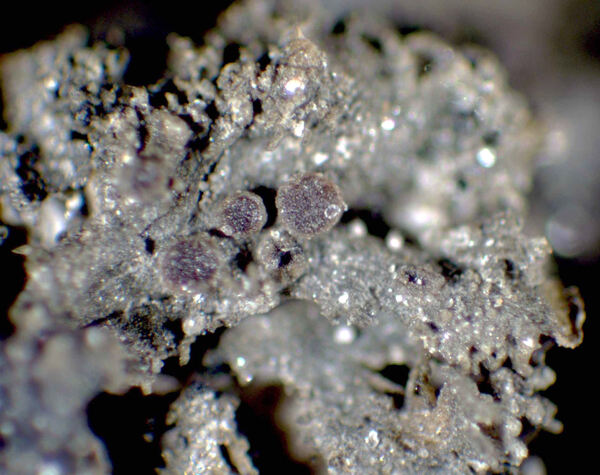Koerberia biformis A. Massal.
Geneac. Lich.: 6, 1854.
Synonyms:
Description: Thallus minutely foliose, not gelatinous when wet, forming small, 0.5-3 cm wide rosettes, the lobes adnate, elongate, up to 2 mm long and 0.3-0.5(-0.8) mm wide, stellately radiating, dark olive-green to grey geen, turning glaucous green when wet, smooth to slightly wrinkled, with laminal, cylindrical, erect, up to 1 mm tall and 45-75(-90) µm thick isidia. Lower surface pale olive, with tufts of pale, short-celled anchoring hapters. Upper cortex (pseudocortex) composed of only one or two discontinuous layers of cells, lower cortex pseudoparenchymatous with short-celled, longitudinally extended hyphae. Apothecia frequent, deep red-brown, soon convex, 0.4-1 (-1.5) mm across, soon emarginate. Proper margin formed by a 30-60 µm wide pseudoexciple; epithecium brownish; hymenium colourless, 65-100 µm high, I+ blue; hypothecium colourless, partly pseudoparenchymatous. Asci 8-spored, cylindrical-clavate, with an apically thickened wall. Ascospores 1-celled, hyaline, acicular to slightly curved, spirally twisted in the asci, 35-45(-55) x 1.5-3(-4) µm. Pycnidia laminal, pyriform, with a brown ostiole. Conidia bacilliform, 4.5-6 x c. 1 µm. Photobiont cyanobacterial, Scytonema-like, the cells 6-10 x c. 15 µm, often arranged in short filaments. Spot tests: all negative. Chemistry: without lichen substances.
Growth form: Foliose, narrow lobed
Substrata: bark
Photobiont: cyanobacteria, filamentous (e.g. Nostoc, Scytonema)
Reproductive strategy: mainly sexual
Most common in areas with a humid-warm climate (e.g. most of Tyrrenian Italy)
Commonnes-rarity: (info)
Alpine belt: absent
Subalpine belt: absent
Montane belt: very rare
Dry submediterranean belt: extremely rare
Humid submediterranean belt: rather rare
Padanian area: absent
pH of the substrata:
1 2 3 4 5
Solar irradiation:
1 2 3 4 5
Aridity:
1 2 3 4 5
Eutrophication:
1 2 3 4 5
Poleotolerance:
0 1 2 3
Altitudinal distribution:
1 2 3 4 5 6
Rarity
absent
extremely rare
very rare
rare
rather rare
rather common
common
very common
extremely common
Loading data...
Occurrence data
Predictive map
Growth form: Foliose, narrow lobed
Substrata: bark
Photobiont: cyanobacteria, filamentous (e.g. Nostoc, Scytonema)
Reproductive strategy: mainly sexual
Most common in areas with a humid-warm climate (e.g. most of Tyrrenian Italy)
Commonnes-rarity: (info)
Alpine belt: absent
Subalpine belt: absent
Montane belt: very rare
Dry submediterranean belt: extremely rare
Humid submediterranean belt: rather rare
Padanian area: absent
pH of the substrata:
| 1 | 2 | 3 | 4 | 5 |
Solar irradiation:
| 1 | 2 | 3 | 4 | 5 |
Aridity:
| 1 | 2 | 3 | 4 | 5 |
Eutrophication:
| 1 | 2 | 3 | 4 | 5 |
Poleotolerance:
| 0 | 1 | 2 | 3 |
Altitudinal distribution:
| 1 | 2 | 3 | 4 | 5 | 6 |
Rarity
absent
extremely rare
very rare
rare
rather rare
rather common
common
very common
extremely common
Loading data...
Occurrence data
Predictive map









